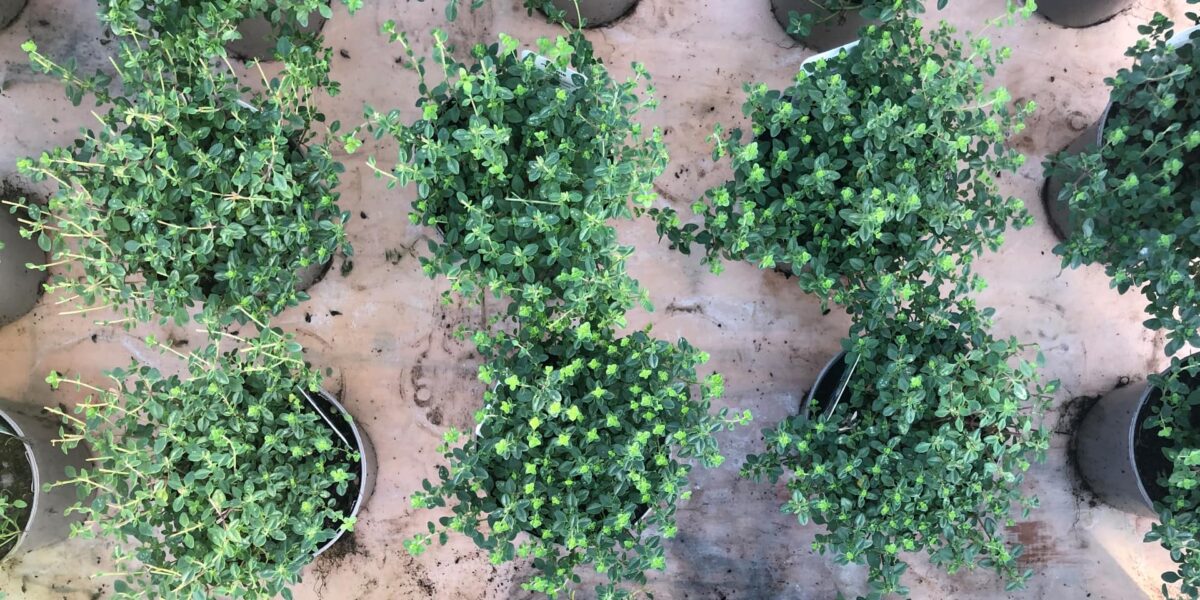 20 October 2022 | Horticulture Hacks
20 October 2022 | Horticulture Hacks
Garden Herbs Horticulture Hacks

Garden Herbs are the focus this week especially Sage. Nurtured in Norfolk’s gardening expert Martyn Davey answers all your questions and gives his top horticulture hacks.
If you would like any horticulture query answered please do e-mail our head grower at martyn@nurturedinnorfolk.co.uk to add your thoughts to our horticulture hacks.
Dear Martyn,
I have a problem I hope you can help me with, this summer I have planted up some white butler sinks with lots of different garden herbs, most of which I had around the garden. I bought some extras from a local nursery including Sage and Moroccan Mint. Both have grown well as have the other herbs including some other mints, thyme and oregano. The problem I have is all the leaves have tiny little white spots on them and when you brush past the sage to pick it or another herb, clouds of little white or light green bugs fly up. My question is are the bugs and the spots connected? If so, how do I control them or get rid of them and can I still eat the herbs?
R Palmerston, Fakenham.
Dear Reader,
The problem is quite common and caused by sage and Ligurian leafhoppers which causes a coarse pale mottling on sage, rosemary, lavender, mint and related plants in the spring and summer. Leafhoppers are small sap-feeding insects that feed on the undersides of leaves. Sage and Ligurian leafhoppers are similar in appearance, they suck sap from aromatic plants in the Lamiaceae family, including sage, mints, lavender, bergamot, marjoram, oregano, rosemary, basil, thyme, and lemon balm. Their feeding causes a course pale mottling of the foliage.
These leafhoppers are widespread in the UK. The adults are up to 3.5mm long, pale green and heavily dappled with brown and black markings. The adult insects are broadest at the head end and sit with their wings folded back over their bodies. When disturbed, they readily jump and can fly short distances. The nymphs are creamy white in colour and do not have fully formed wings. As leafhopper nymphs grow they shed their skins several times. The discarded white skins can often remain attached to the lower leaf surface and are sometimes referred to as ‘ghost insects’. These leafhoppers overwinter as eggs on its host plants and are active from May until the autumn.
Damage caused by sage and Ligurian leafhoppers can generally be tolerated by host plants, and so control is not necessary. Affected herbs are safe to eat. Check susceptible plants frequently from spring onwards so action can be taken before a damaging infestation has developed. Often leafhoppers do not affect the growth or vigour of plants and so can be tolerated. Encourage predators and other natural enemies of leafhoppers, in the garden, such as birds, ladybirds, wasps and ground beetles, these will all help to control other pests as well.
If you need to use chemicals try to go for the non-persistent ones such as organic sprays, such as natural pyrethrum (e.g. Bug Clear Gun for Fruit & Veg, Neudorff Bug Free Bug and Larvae Killer), fatty acids (e.g. Solabiol Bug Free, Doff Greenfly & Blackfly Killer) or plant oils (e.g. Vitax Plant Guard Pest & Disease Control, Bug Clear for Fruit and Veg) can give good control of leafhoppers. These pesticides have a very short persistence and so may require reapplication to keep leafhopper numbers in check. Plant oil and fatty acid products are less likely to affect larger insects such as ladybird adults.
Plant invigorators combine nutrients to stimulate plant growth with surfactants or fatty acids that have a physical mode of action (e.g. Ecofective Bug Control, RHS Bug and Mildew Control, SB Plant Invigorator and Westland Resolva Natural Power Bug & Mildew). These are not considered organic.
More persistent contact-action insecticides include the synthetic pyrethroids lambda-cyhalothrin (e.g. Westland Resolva Bug Killer), deltamethrin (e.g. Provanto Ultimate Fruit & Vegetable Bug Killer, Provanto Sprayday Greenfly Killer) and cypermethrin (e.g. Py Bug Killer)
Follow label instructions when using pesticides. On edible plants make sure the food plant is listed on the label and follow instructions on maximum number applications, spray interval and harvest interval. Plants in flower should not be sprayed due to the danger to bees and other pollinating insects.
Jobs for this week
- Now is the time to cut back hedges, trim them now and there will be little growth until next spring and no chance of disturbing nesting birds.
- Thin or bare patches of lawn can be re-sown or over sown now that the weather has cooled and we are getting regular rain. With temperatures above 10C the seed will germinate quickly.
- Many plants have seeds that can be collected now ready to sow either straight away or in spring. Remember to store the seed in a paper envelope and mark on it what it is and date collected.

